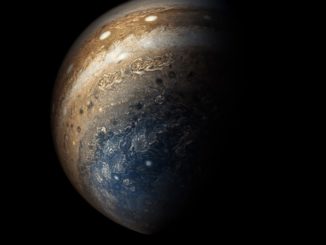
Intermittent flows that appear on steep slopes on Mars are likely formed by flowing sand, and not water as some scientists previously suspected, according to a new study.
Measurements of the slopes where the flows were found on Mars show they are much like the sides of active dunes, steep enough to allow dry grains to descend with the pull of gravity.
The features were first discovered in images from NASA’s Mars Reconnaissance Orbiter in 2011 as narrow, dark streaks that appear in summer and fade in winter, then form again the next year. Scientists named the dark streaks recurring slope lineae, or RSL, and set out to learn more about them.
There are no rovers close enough to any of the streaks to study them up-close. The observations so far have all come from instruments aboard satellites orbiting Mars.
Scientists announced in 2015 they found hydrated salts, or perchlorates, around many of the intermittent flows. Such minerals can lower the freezing point of a liquid brine, a syrup-like mixture of water and salt that could temporarily survive in the extremely cold temperatures and low air pressure at the Martian surface.
The discovery of perchlorates around the dark streaks led scientists to suggest briny water could seep up from underground, then flow down slopes and darken the soil, creating the flows visible in imagery captured by MRO’s telescopic HiRISE camera.
New research indicates flowing sand is a more likely explanation for the streaks.
“We’ve thought of RSL as possible liquid water flows, but the slopes are more like what we expect for dry sand,” said Colin Dundas, a scientist at the U.S. Geological Survey and lead author of the study published in Nature Geoscience on Nov. 20. “This new understanding of RSL supports other evidence that shows that Mars today is very dry.”
MRO’s sharp-eyed HiRISE camera has found thousands of the streaks in more than 50 regions, extending from the Martian equator about halfway to the poles, NASA said.

Using imagery from HiRISE, scientists modeled the steepness of slopes at 10 sites where 151 flows were discovered. Almost all of the slopes were steeper than 27 degrees, and each streak ends at the same “stopping angle” as dry sand flows on the sides of dunes on Mars and Earth.
The stopping angles — or dynamic angle of repose — on all 151 features matched, even though the flows had different lengths.
“The RSL don’t flow onto shallower slopes, and the lengths of these are so closely correlated with the dynamic angle of repose, it can’t be a coincidence,” said Alfred McEwen from the University of Arizona, a co-author of the Nature Geoscience report and principal investigator for MRO’s HiRISE camera.
Scientists said liquid water flows should extend to more gentle slopes.
The findings “align with the long-standing hypothesis that the surface of Mars lacks flowing water,” the USGS said in a press release.
The flows were thought to be ripe ground to search for microbial life on Mars. Liquid water, even if it is saturated with salts and intermittent, could support colonies of simple organisms.
But the latest findings “argue against the presence of enough liquid water for microbial life to thrive at these sites,” NASA said in a a press release. “However, exactly how these numerous flows begin and gradually grow has not yet been explained.”
The presence of hydrated salts — minerals that have water in their chemical structures — around the flows, and their propensity to appear in warm seasons suggest small amounts of water may still play a role in their formation. The salts could obtain water from the Martian atmosphere, and their expansion or contraction could trigger grain flows as temperatures warm.
Dundas and his colleagues concluded that liquid on present-day Mars may be limited to traces of dissolved moisture from the atmosphere and thin films of water, according to a USGS statement on the findings.
“RSL probably form by some mechanism that is unique to the environment of Mars, so they represent an opportunity to learn about how Mars behaves, which is important for future surface exploration,” McEwen said in a NASA press release.
An on-the-ground study of the flows by a future Mars rover could give scientists a more definitive answer.
“Full understanding of RSL is likely to depend upon on-site investigation of these features,” said Rich Zurek, MRO project scientist at NASA’s Jet Propulsion Laboratory. “While the new report suggests that RSL are not wet enough to favor microbial life, it is likely that on-site investigation of these sites will still require special procedures to guard against introducing microbes from Earth, at least until they are definitively characterized. In particular, a full explanation of how these enigmatic features darken and fade still eludes us. Remote sensing at different times of day could provide important clues.”
Email the author.
Follow Stephen Clark on Twitter: @StephenClark1.



